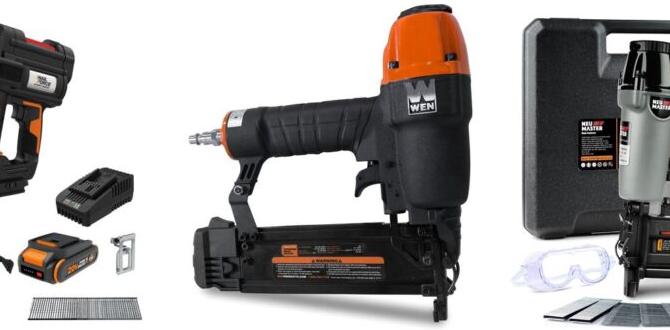For most DIY projects, both high-quality cordless and air nailers offer excellent longevity, but air nailers often outlast cordless models due to simpler mechanics and fewer wear-prone components. However, modern cordless technology is rapidly closing the gap, making the best choice dependent on your specific needs and maintenance habits.
Choosing the right nailer can feel a bit overwhelming, especially when you want it to last through many projects. You’ve probably heard about both cordless nailers and air (pneumatic) nailers, and maybe you’re wondering which one will be your trusty sidekick for years to come. Will that battery-powered convenience eventually let you down, or can that air-powered workhorse keep going and going? It’s a super common question for DIYers, and no one wants to invest in a tool that won’t stand the test of time. Don’t worry, I’m here to break it down for you in a way that makes sense. We’ll look at what makes each type tick, how they age, and what you can do to ensure your nailer serves you well, project after project. Get ready to find out which nailer is built for the long haul!
Table of Contents
Cordless Nailer vs Air Nailer: The Longevity Showdown
When we talk about “longevity” for nailers, we’re really asking: “Which one will work reliably for the longest time with proper care?” It’s about durability, resistance to wear and tear, and how well it holds up under repeated use. Both cordless and air nailers can be incredibly durable, but they achieve this in different ways, and their potential for long-term service has unique characteristic
Think of it like this: an air nailer is a simpler machine at its core. It relies on compressed air to drive a piston, which fires the nail. There are fewer complex electronic components to worry about. A cordless nailer, on the other hand, uses a battery to power a motor and a flywheel or a compressed air spring system. This introduces more elements that could potentially wear out over time.
Understanding How Nailers Work (The Basics): Air Power
Air nailers, also known as pneumatic nailers, have been the workhorses of construction and woodworking for decades. Their operation is elegantly simple:
- The Compressor: An external air compressor stores compressed air in a tank.
- The Hose: A flexible hose connects the compressor to the nailer.
- The Trigger Mechanism: When you pull the trigger, a valve opens, allowing compressed air to flow into the nailer’s cylinder.
- The Piston: This burst of air pushes a piston down rapidly.
- The Driver Blade: The piston strikes a driver blade (a small metal rod), which then drives the nail through the material.
- The Exhaust: After firing, the air is vented (often with that characteristic “puff” sound).
This system is robust because the main pneumatic components are sealed and designed for high pressure and rapid cycling. While the compressor itself has moving parts and the hose can wear, the nailer tool itself is often incredibly resilient.
Pros of Air Nailer Design for Longevity:
- Fewer electronic components means less to fail electronically.
- Simpler mechanical action is often more robust and easier to maintain.
- The tool itself is typically lighter than a comparable cordless model because the battery and motor are external.
Understanding How Nailers Work (The Basics): Cordless Power
Cordless nailers have revolutionized job sites and workshops by untethering users from compressors and hoses. They come in a few main varieties:
- Gas Cartridge/Propane: These use a small disposable gas cartridge. A small amount of fuel is injected into a combustion chamber, ignited by a spark plug, and the resulting explosion drives a piston. These are powerful but require ongoing fuel purchases and can be sensitive to temperature.
- Battery-Powered (Electric): This is the most common type these days. These nailers use one of two primary methods to drive the nail:
- Flywheel System: A powerful electric motor spins a flywheel to a very high speed. When you pull the trigger, a clutch engages, transferring the flywheel’s momentum to a piston, which drives the nail.
- Compressed Air Spring System: These tools contain a small internal air cylinder. A motor pumps air into this cylinder, compressing a spring. When you pull the trigger, the compressed air is released to drive a piston, similar to an air nailer, but on a much smaller scale.
The longevity of cordless nailers hinges on the durability of their power source (battery), motor, and the specific mechanism used to drive the nail. Batteries have a finite number of charge cycles. Motors and the associated gears or clutch mechanisms can experience wear. The compressed air spring systems, while simpler than flywheel systems, still have seals and internal components that can degrade.
Pros of Cordless Nailer Design for Longevity (Modern Types):
- Freedom from hoses and compressors means less potential for hose damage or compressor failure.
- Integrated system often leads to easy setup and portability.
Factors Affecting Nailer Longevity
Regardless of whether you choose cordless or air, several factors will influence how long your nailer lasts. Proper care and understanding these elements are key to maximizing its lifespan.
1. Build Quality and Materials
This is perhaps the most significant factor for any tool. A nailer constructed with high-quality metals (like hardened steel for pistons and driver blades) and durable housing (often magnesium or robust polymer) will inherently last longer than one made with cheaper materials.
- High-End Models: Reputable brands often invest in better materials and tighter manufacturing tolerances. This results in a tool that feels more solid, operates more smoothly, and resists wear better.
- Budget Models: While they can get the job done, cheaper nailers might use softer metals or plastics that can bend, crack, or break under heavy use, or their internal seals might be less robust.
2. Intended Use vs. Actual Use
Nailers are designed for specific tasks. Using a tool outside its intended application can drastically shorten its life.
- Framing Nailers: Built for driving large nails into dense lumber. Using them for delicate trim work can lead to over-penetration and damage.
- Finish Nailers: Perfect for trim and molding. Trying to drive them into hardwoods or framing lumber consistently will likely lead to jams, bent nails, and premature wear on the driver blade and piston.
- Brad Nailers: For very fine work; not meant for structural applications.
Consistently using a nailer for tasks beyond its designed capacity (e.g., repeatedly trying to drive nails into very hard materials where the tool struggles) puts immense stress on its internal components, leading to faster wear.
3. Maintenance and Care
This is where you, the user, have the most control. Proactive maintenance is crucial for both cordless and air nailers.
- Air Nailers:
- Oiling: Regular oiling of the air inlet is critical. The oil lubricates the piston and seals, reducing friction and wear significantly. Many manufacturers recommend a few drops of specialized “nailer oil” before each use.
- Cleanliness: Keeping the tool clean, especially the magazine where nails are fed, prevents debris from jamming the mechanism.
- Air Quality: Using a good quality air filter and water separator on your compressor prevents moisture and debris from entering the nailer and causing corrosion or premature wear. A clean, dry air supply is vital. See resources from the Occupational Safety and Health Administration (OSHA) on maintaining pneumatic tools safely, which includes clean air.
- Cordless Nailers:
- Battery Care: Follow the manufacturer’s guidelines for charging and storing batteries. Don’t leave them in extreme temperatures. Recharge when needed but avoid over-discharging.
- Cleanliness: Just like air nailers, keeping the magazine free of sawdust and debris is essential for reliable feeding.
- Storage: Store the tool in a dry place. For long-term storage, it’s often recommended to store batteries at about a 50% charge.
- Internal Cleaning: Some cordless models may require occasional internal cleaning or lubrication of specific parts as per the manual.
4. Battery Technology (for Cordless)
The battery is a significant component in cordless tools, and its lifespan is finite. While modern lithium-ion batteries are robust and can last for hundreds, if not thousands, of charge cycles, they will eventually degrade. This means reduced run-time and power.
The longevity of the battery itself is separate from the longevity of the tool’s motor. However, a failing battery can lead to the tool performing poorly, which might encourage users to overwork it. Replacement batteries can be expensive, so consider this when evaluating the total cost of ownership over many years.
Cordless Nailer vs Air Nailer: Longevity Comparison
Let’s put them head-to-head on the longevity front, considering their typical lifespans and how they might age.
Air Nailers: The Marathon Runners?
Air nailers, when well-maintained, are legendary for their durability. Because the tool itself is driven by a relatively simple pneumatic system, it’s less prone to the kind of electronic or battery-related failures that cordless tools can experience.
- Component Lifespan: The core pneumatic components (piston, seals, cylinder, valves) are designed for high pressures and repeated use. With proper lubrication and clean air, these can last for many years, easily racking up hundreds of thousands of cycles.
- Wear and Tear: Wear primarily occurs on seals and the piston/cylinder due to friction, which is mitigated by regular oiling.
- External Factors: The compressor is the main component that can fail (motor, pump), but it’s a separate unit. The hose can wear out, but it’s easily replaced.
- Cost of Longevity: While the initial tool cost might be lower than a high-end cordless, the ongoing cost of a compressor, hoses, and fittings is substantial. However, the compressor can power multiple air tools, making its cost less directly attributable solely to the nailer.
Table: Air Nailer Longevity Factors
| Factor | Impact on Longevity | User Influence |
|---|---|---|
| Pneumatic System Simplicity | High; fewer complex parts to fail. | Minimal; inherent design advantage. |
| Lubrication & Maintenance | Critical; reduces friction, wear, and corrosion. | High; requires consistent oiling and cleaning. |
| Air Quality (Clean & Dry) | Essential; prevents internal damage and corrosion. | High; requires proper compressor setup and filter maintenance. |
| Material Quality | High; robust construction ensures resistance to impact and wear. | Moderate; choosing reputable brands helps. |
| Battery/Motor Failure | N/A; not present in the nailer tool itself. | N/A |
Cordless Nailers: The Evolution of Durability
Cordless technology has made incredible strides. Early cordless tools were often underpowered and less reliable, but modern battery-powered nailers are powerful, efficient, and increasingly durable.
- Battery Lifespan: Lithium-ion batteries typically last 3-5 years or 500-1000 charge cycles, depending on usage and care. This is a definite consumable component.
- Motor/Flywheel Life: The electric motors and associated mechanical systems (like flywheels or internal air springs) are generally robust. High-end models are built for thousands of hours of operation.
- Wear Points: Wear can occur in the motor brushes (if brushed), gears, clutch mechanisms, and seals within the pneumatic spring systems. Continuous heavy use can accelerate this wear.
- Cost of Longevity: The upfront cost is higher, and replacement batteries can be a significant recurring expense. However, the absence of a compressor and hoses streamlines operation.
The longevity of a cordless nailer is often tied to the lifespan of its battery and the durability of its specific driving mechanism. The convenience factor is undeniable, and for many DIYers, the extended lifespan of modern cordless tools is more than sufficient for their needs.
Table: Cordless Nailer Longevity Factors
| Factor | Impact on Longevity | User Influence |
|---|---|---|
| Battery Lifespan | Limited; needs replacement after several years. | High; proper charging and storage prolong battery life. |
| Motor & Driving Mechanism | Generally high for quality tools; specific designs vary. | Moderate; proper use (not forcing) and cleaning are key. |
| Electronic Components | Present; more potential points of failure than air tools. | Low; usually out of user control unless exposed to damage. |
| Maintenance | Less oiling than air tools; focus on cleanliness and battery care. | High; keeping the tool clean and batteries maintained. |
| Portability & Convenience | High; can contribute to more frequent or varied use. | N/A; an operational benefit. |
Cordless Nailer Longevity: A Deeper Dive
Let’s explore the nuances of cordless nailer longevity. It’s not just about if they last, but how they last.
Battery Technology and Degradation
Lithium-ion (Li-ion) batteries are standard for modern cordless tools. They offer good power density and hold a charge well. However, like all batteries, they degrade over time.
- Charge Cycles: Each time you fully charge and discharge a battery, it counts as a charge cycle. Most high-quality Li-ion batteries are rated for 500-1000 full cycles. If you use your nailer heavily, you might reach this limit in 3-5 years.
- Heat and Cold: Extreme temperatures significantly impact battery health. Avoid charging or storing batteries in freezing temperatures or direct, hot sunlight.
- Deep Discharges: Completely draining a battery regularly can shorten its lifespan. Most modern tools have under-voltage protection, but it’s good practice to recharge before the tool completely stops working.
For a DIYer using a nailer for occasional projects, a battery might last 5-7 years or even longer before its capacity noticeably diminishes.
Motor and Driving Mechanism Wear
This is where the “flywheel” vs. “compressed air spring” designs come into play regarding long-term wear.
- Flywheel Systems: These use high-speed motors and a clutch mechanism. The motor itself is usually very robust and designed for thousands of hours of operation. The clutch mechanism is a wear item that engages and disengages rapidly, but quality clutches are built to last. The primary wear points would be the motor brushes (if it’s a brushed motor, though brushless is becoming more common and lasts longer) and the clutch assembly.
- Compressed Air Spring Systems: These are arguably closer to the simplicity of air nailers. A motor is used to compress a small internal air spring. When fired, a valve releases this compressed air to drive a piston. Longevity here depends on the durability of the motor, the seals within the internal cylinder, and the valve mechanism. These systems often feel very similar to air nailers and can be very robust if well-engineered.
Many users report that high-quality cordless nailers from top brands can easily last from 5 to 10 years of moderate DIY use. The main eventual failure point for many will be the battery.
For a fantastic resource on battery tool maintenance and longevity, check out tips from organizations like Tooling.org, which discusses industrial applications of power tools and their components.
Air Nailer Longevity: The Enduring Classic
Air nailers have a reputation for being virtually indestructible, and for good reason. Their mechanical simplicity is their greatest asset when it comes to longevity.
Simplicity Breeds Durability
An air nailer is essentially a cylinder with a piston, a few seals, and a valve. When maintained properly:
- Seals: O-rings and seals are the primary wear components. They degrade over time


